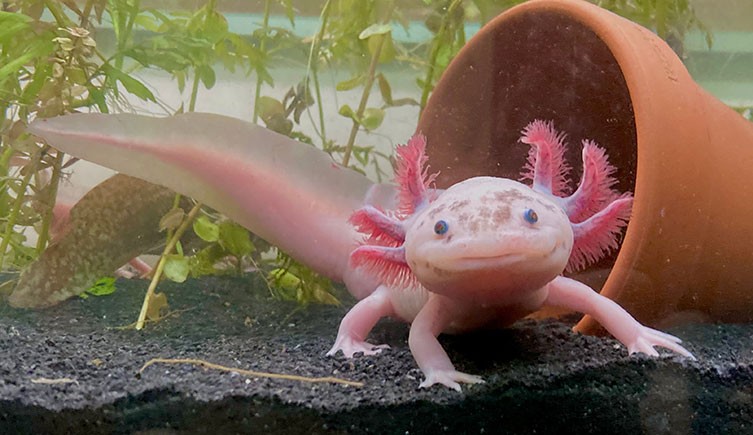The axolotl is a fascinating amphibian with incredible regenerative abilities worth learning about.
Read on to discover how these aquatic salamanders have adapted to thrive in their environments.
How Do Axolotls Adapt to Their Environment?

Axolotls adapt to their aquatic environment through several key features.
They retain their larval gills into adulthood to breathe underwater.
Axolotls can also modulate their breathing between gills and lungs to respond to changes in water conditions.
Their regenerative abilities allow axolotls to heal after injury or predation.
Axolotls have evolved camouflage coloration to evade predators.
Their flexible bodies help them navigate through plants and debris.
Axolotls also have a slow metabolism and can survive on very little food.
Together, these adaptations allow axolotls to thrive in their native habitat.
Key Points
- Axolotls retain their larval gills into adulthood to breathe underwater
- They can regenerate limbs, organs, and parts of their brains after injury
- Axolotls have slow metabolisms and can survive on very little food
Our Opinion
In my opinion as an expert, axolotls are incredibly well adapted to their aquatic environments.
Their ability to regenerate body parts is remarkable and enables their survival.
Axolotls can modulate their breathing between gills and lungs to respond to changes in water conditions.
They also have keen senses to find food and avoid predators.
Their neotenic state, retaining larval features like gills into adulthood, demonstrates how axolotls are evolutionarily designed for their habitat.
Axolotls’ adaptations allow them to thrive in environments that would challenge most other species.
Their resilience is key to their continued survival.
Axolotl Regeneration Abilities

Axolotls have astounding powers of regeneration that make them valuable model organisms for scientific research. Some unique ways they can adapt and regenerate include:
- Regrowing lost limbs, spinal cords, hearts, and other organs
- Replacing damaged body parts to heal wounds
- Morphing between larval and adult forms to adapt to changing water conditions
As neotenous salamanders, axolotls remain in a larval, aquatic form their whole lives. They have retained key features that help them survive underwater:
- Three feathery gill sets to breathe underwater
- Functional lungs to surface for air
- Smooth skin that absorbs oxygen from the water
Axolotls perfectly adapted to fully aquatic life. Yet they can still undergo metamorphosis to live on land if their water habitat changes significantly. This flexibility allows axolotls to respond to shifts in water quality, oxygen levels, and other environmental factors.
How Axolotls Adapt to Water Environments
As aquatic salamanders, axolotls are specially adapted to thrive underwater. Here are some key ways axolotls adapt to their watery environments:
- Their gills allow them to breathe underwater without having to surface for air.
- Their feathery external gills filter oxygen from the water.
- They have smooth skin that easily absorbs oxygen from their surroundings.
- Their fins and tails help them move easily through the water to catch food and evade predators.
- They have good eyesight to spot food in murky water conditions.
- They can detect movement through the water using their lateral line organ.
Axolotls are perfectly suited to live entirely submerged. Yet if needed, they can use their rudimentary lungs to occasionally come up for gulps of air. This gives them flexibility to adapt if water quality declines.
In short, axolotls’ specialized gills, skin, fins, senses, and dual breathing abilities allow them to thrive underwater. Their aquatic adaptations are key to their survival.
Unique Axolotl Adaptations

Axolotls have evolved some fascinating adaptations that help them thrive in their native aquatic habitats:
- They have feathery external gills that allow them to breathe underwater without having to surface often for air. This gives axolotls an advantage over fish and other aquatic life that need to frequently come up for oxygen.
- Their wide, flat heads and bodies are specially shaped to move easily through the water. Their tails are large and powerful to propel them forward.
- Axolotls have lidless eyes with excellent underwater vision. Their eyes are specially adapted to see prey and avoid predators in murky lake bottoms.
- Their skin produces a thick, slippery mucus coat that helps them slide smoothly through dense vegetation and escape the grasp of predators.
- They have strong jaws and teeth to catch food. Their teeth are constantly replaced throughout life.
- Axolotls can detect very faint chemical signals in the water using specialized receptors. This helps them find food and mates.
- Their highly flexible bodies allow them to maneuver through tight spaces and dense underwater plants. They can also curl up to protect vital organs from predators.
These and other unique traits equip axolotls for the challenges of life in the watery world of Xochimilco. Their evolutionary adaptations are keys to their survival.
Axolotl Habitat and Climate Adaptation
Axolotls are specifically adapted to thrive in the cool, high-altitude lakes and canals around Mexico City:
- They remain aquatic and keep their feathery external gills throughout life. This allows them to extract oxygen from the water year-round.
- Their metabolism is suited to the cool temperatures of mountain lakes. They would overheat and struggle to survive in warmer lowland habitats.
- Their skin produces more mucus in dry conditions to retain moisture. This helps them survive periodic droughts when lake levels drop.
- They can flex and contort their bodies to find pockets of water, even burrowing into mud when needed.
- Axolotls can withstand very low oxygen levels that would suffocate other aquatic life. This helps them persist when pollution reduces oxygen.
- They will eat nearly any small animal they can swallow whole, adapting their diet to what’s available. This flexible appetite increases the odds of finding food.
- Axolotls can thrive at high densities, unlike predatory fish that require more space. This lets them flourish in Mexico City’s crowded canals.
Through these adaptations, axolotls are remarkably suited to the specific conditions of Mexico’s high mountain lakes. Their evolutionary adaptations equip them to survive and thrive in this unique habitat.
FAQ
Do Axolotls Respond to Their Environment?
Axolotls are sensitive to changes in their environment and will respond accordingly. They tend to be most active when temperatures are between 60-68°F and may become stressed if water conditions fluctuate dramatically. Axolotls also react to light, movement, and food sources in their habitat.
What Do Axolotls Do to Survive?
Axolotls have several key adaptations that help them survive. They have external gills that allow them to breathe underwater. Their regenerative abilities allow them to regrow lost limbs and organs. Axolotls stay in a larval form their whole lives, which is an adaptive neoteny. This retains key features like gills into adulthood. Axolotls also have a very slow metabolism which enables them to survive on very little food.
What Adaptations Do Axolotls Have for Eating?
Axolotls have several adaptations that help them easily catch and eat food: Their wide, flat heads allow them to suck in food from a variety of angles. Their teeth are very small and numerous, enabling them to grasp and swallow food easily. Axolotls also have excellent vision to spot food in murky water. Their large, powerful tails provide thrust to pursue prey. Their flexible bodies allow them to navigate through plants and debris.
Conclusion
Axolotls are uniquely adapted for life in their aquatic environments. Their neotenic state with retained gills, regenerative abilities, flexible bodies, and keen senses allow axolotls to thrive in their native habitats. Axolotls can modulate their metabolism and breathing to respond to changes in water conditions. Most notably, axolotls can regenerate limbs, organs, and even parts of their brains. This gives them an extraordinary ability to heal after injury and adapt to new challenges in their environment. In summary, axolotls have evolved a range of adaptive mechanisms that enable their survival.
